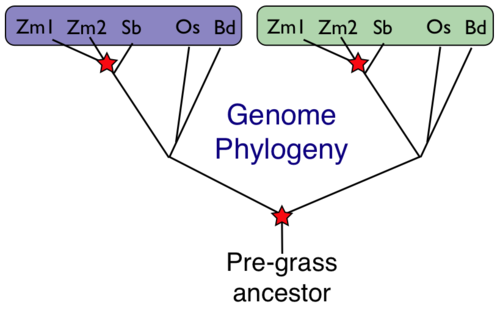Pan-grass synteny: Difference between revisions
Jump to navigation
Jump to search
No edit summary |
No edit summary |
||
| Line 4: | Line 4: | ||
The grass family of plants, [http://www.mobot.org/MOBOT/research/APweb/orders/poalesweb.htm#Poaceae poaceae], radiated 50-70 million years, around the time that dinosaurs were going extinct and mammals were one the rise. Today, they are one of the largest families of plants with worldwide distribution. Several members of poaceae are agronomically important, being major sources of food for the majority of human populations. As such, they are the center of much applied and basic scientific research. | The grass family of plants, [http://www.mobot.org/MOBOT/research/APweb/orders/poalesweb.htm#Poaceae poaceae], radiated 50-70 million years, around the time that dinosaurs were going extinct and mammals were one the rise. Today, they are one of the largest families of plants with worldwide distribution. Several members of poaceae are agronomically important, being major sources of food for the majority of human populations. As such, they are the center of much applied and basic scientific research. For more information on this illustrious family, please see [http://www.mobot.org/MOBOT/research/APweb/orders/poalesweb.htm#Poaceae this site by Peter Stevens from the Missouri Botanical Gardens]. | ||
Revision as of 23:50, 11 March 2010


The grass family of plants, poaceae, radiated 50-70 million years, around the time that dinosaurs were going extinct and mammals were one the rise. Today, they are one of the largest families of plants with worldwide distribution. Several members of poaceae are agronomically important, being major sources of food for the majority of human populations. As such, they are the center of much applied and basic scientific research. For more information on this illustrious family, please see this site by Peter Stevens from the Missouri Botanical Gardens.